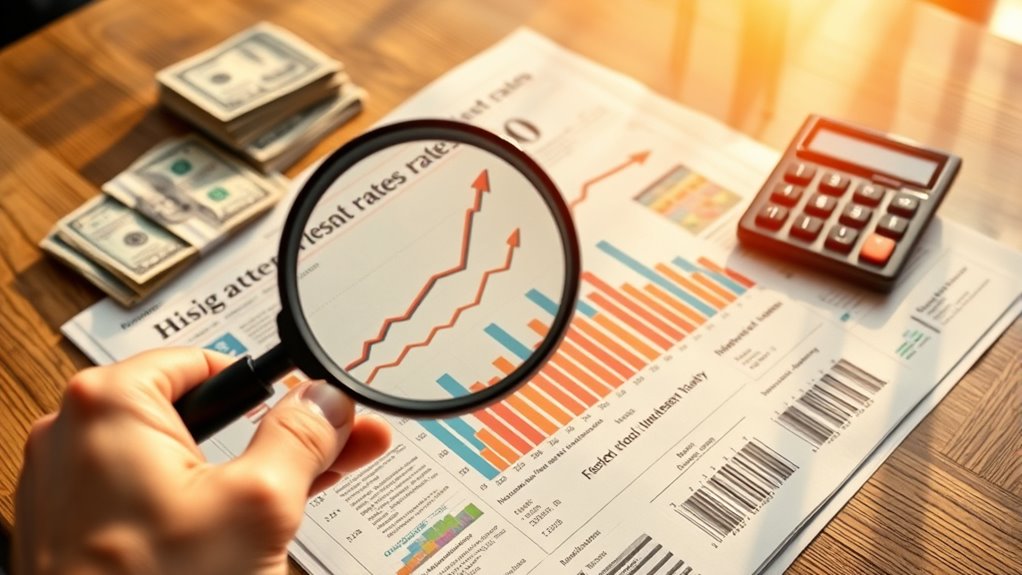When the federal interest rate rises, your borrowing costs go up, making loans for homes, cars, and credit more expensive, which can tighten your budget. Meanwhile, savings accounts and fixed income investments might offer better returns, boosting your interest income. Conversely, when rates fall, borrowing becomes cheaper, but your savings earn less. These changes can impact your daily finances and future planning—stay with us to explore how these shifts can shape your financial well-being.
Key Takeaways
- Higher interest rates increase borrowing costs, making loans for homes, cars, and credit more expensive, reducing affordability.
- Rising rates boost savings yields, helping earn more from savings accounts and fixed-income investments.
- Rate hikes can slow economic growth and reduce job opportunities, impacting income stability and consumer spending.
- Lower interest rates make borrowing easier, encouraging spending and investment, which can stimulate economic growth.
- The Federal Reserve uses interest rate adjustments to control inflation, preserving money’s purchasing power over time.

When interest rates go up, borrowing becomes more expensive. If you’re planning to buy a home, finance a car, or take out a personal loan, higher rates mean increased monthly payments. This can make big purchases less affordable and might slow down your spending. Conversely, if the Fed lowers interest rates, borrowing costs decrease, making it cheaper to finance big-ticket items. You might find it easier to get a loan or mortgage, which can boost your purchasing power.
Your savings also feel the impact. Higher interest rates often lead to better returns on savings accounts, CDs, and other fixed-income investments. If you’re someone who relies on interest income, you’ll benefit from the increased yields during periods of rate hikes. On the other hand, when rates fall, your savings might generate less income, which could influence your financial planning and retirement strategies.
The broader economy’s health, influenced by the Fed’s monetary policy, also affects job stability and wages. When the Fed raises interest rates to control inflation, it often aims to slow economic growth slightly. This can lead to fewer job opportunities or slower wage increases, impacting your income and savings potential. Conversely, lowering interest rates can stimulate economic activity, potentially leading to more jobs and higher wages, which benefits your financial situation.
Inflation control is a key reason behind these rate adjustments. When inflation rises too quickly, the Fed raises rates to cool down spending and prevent prices from spiraling out of control. This is vital because unchecked inflation erodes purchasing power, making everyday goods more expensive. By managing inflation through interest rate changes, the Fed helps preserve the value of your money over time.
Additionally, the use of AI in financial modeling by central banks can improve the accuracy of monetary policy decisions, further influencing interest rate adjustments that impact your wallet.
Frequently Asked Questions
How Often Does the Federal Reserve Change Interest Rates?
The Federal Reserve typically reviews its interest rate policies every six weeks during Federal Open Market Committee (FOMC) meetings, but actual changes happen less frequently—usually a few times a year. These interest rate cycles depend on economic conditions, inflation, and employment data. You should stay informed about FOMC announcements, as they directly influence borrowing costs, savings, and overall economic stability, impacting your financial decisions.
Can I Benefit From Rising Interest Rates?
Yes, you can benefit from rising interest rates. When rates increase, savings accounts and bonds typically offer higher returns, creating new investment opportunities. For example, a 1% rise in interest rates can boost your savings income by a notable margin. Rising rates also help with inflation control, stabilizing prices. By adjusting your investments accordingly, you can take advantage of these changes and enhance your financial growth.
Do Low Rates Affect Small Business Loans?
Low interest rates make small business loans more accessible, helping you expand your business or manage cash flow. When rates are low, consumers tend to spend more, boosting overall economic activity. However, if you carry credit card debt, low rates might tempt you to borrow more, increasing debt. Staying mindful of your spending and debt levels guarantees you can take advantage of favorable lending conditions without overextending yourself.
How Do Interest Rate Changes Impact Mortgage Affordability?
When interest rates change, your mortgage affordability shifts. Lower rates mean you pay less interest, making monthly payments more manageable, especially if you have a good credit score. This also opens up refinancing options, allowing you to improve your loan terms or reduce payments. Conversely, higher rates can increase costs, so staying informed helps you plan better and take advantage of favorable rate changes for your financial benefit.
Are Savings Accounts Affected by Interest Rate Fluctuations?
Yes, savings accounts are affected by interest rate fluctuations. When rates rise, your savings grow faster thanks to compound interest, making it a good time to boost your savings strategies. Conversely, lower rates mean less growth. To maximize your earnings, look for high-yield savings accounts and consider regular deposits. Staying informed about rate changes helps you make smarter choices, so your money works harder for you.
Conclusion
Just as Icarus’s wings melted when he flew too close to the sun, your wallet risks overheating with rising interest rates. Staying aware of these shifts keeps you grounded, helping you avoid financial pitfalls. Remember, the Federal Reserve’s moves are like the tides—constant and powerful. By keeping an eye on interest rate changes, you can steer your finances wisely and avoid getting burned. So, stay informed and protect your financial flight.









